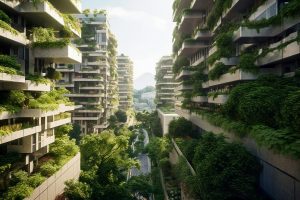Written by Zeina Kalthoum
Reading time: 5 minutes
Green Buildings
For some, green buildings may seem like a luxury or simply involve features like green roofs and walls. To understand their true significance, we need to consider many factors. Why is it important? Because such environments are key in shaping the future of our world, we must raise awareness about it, plus its effects on current and future generations.
We spend a significant amount of our time indoors—at school, work, and home. Unfortunately, many buildings operate on fossil fuels or are poorly insulated. Many are not equipped to withstand the effects of climate change, such as floods and heat waves.
To create climate-friendly buildings, we need to construct better new structures and renovate existing ones, as most will remain for decades. This is why the European Commission has launched a Renovation Wave aimed at improving the energy performance of buildings across the EU. The goal is to double renovation rates by 2030, ensuring these renovations lead to better energy and resource efficiency. By 2030, this initiative could see 35 million buildings renovated, creating up to 160,000 new green jobs in the construction sector!

Definition of Green Building
According to the International City/County Management Association (ICMA), green buildings are designed using an integrated approach to create healthy, comfortable, cost-effective, and environmentally friendly living and working environments. Green building practices focus on developing sustainable sites, enhancing water and energy efficiency, reducing waste and emissions, using eco-friendly materials, and improving indoor environmental quality more effectively than conventional designs.
Energy-inefficient commercial and residential buildings contribute significantly to environmental concerns that negatively impact community sustainability. According to the U.S. Energy Information Administration (EIA), these buildings account for one-third of greenhouse gas emissions in the United States, as well as approximately one-third of total energy use and two-thirds of electricity consumption. By adopting an integrated approach, local governments can change how buildings operate, fostering economic development while protecting the environment and promoting sustainable communities.
The EU Building Industry’s Greener Era
The EU building industry is entering a greener era driven by four major shifts;
- Stricter Regulations: The construction sector is increasingly affected by legislation regarding environmental protection, health and safety, energy efficiency, and social and economic quality.
- Market Shift: Green buildings are becoming the new standard. Investing in non-green buildings will have serious financial consequences in the future. Rating systems for sustainable buildings are being introduced throughout Europe.
- Rising Resource Prices: The increasing prices and volatility of resources (e.g., gas, electricity, and non-renewable natural resources) highlight the need for energy-efficient and recyclable materials in construction.
- Market Awareness: There is a growing preference for sustainable products in construction, emphasizing sound resource management throughout the supply chain, including natural materials with longer lifespans and lower processing.
UAE Building Industry’s Greener Era
Since joining the Paris Agreement in 2017, the UAE has consistently demonstrated its commitment to sustainability. Through investments in renewable energy, energy efficiency, and the promotion of green practices, the UAE actively addresses climate change. Initiatives like the UAE Green Agenda, Energy Strategy 2050, and the Net Zero by 2050 plan, along with hosting COP28, solidify this commitment. Globally, energy-related GHG emissions from the building and construction industries account for 39%. To combat this, the UAE adopted international green building certifications in 2006 to enhance sustainability in the built environment.
In 2010, the UAE Cabinet approved Green and Sustainable Building Standards, mandating their application nationwide for government buildings starting in 2011. These standards are expected to save the country AED 10 billion by 2023 and reduce carbon emissions by nearly 30%. During EXPO 2020, the UAE launched additional green building guidelines to promote high-efficiency buildings and improve existing ones. However, standards can vary between Emirates. Abu Dhabi led the way by mandating the Estidama Pearl Rating System in 2010, with other Emirates following suit. These regulations have raised awareness of the importance of green buildings and created a local market for them.
Linking the UAE and EU Initiatives
The UAE’s green building initiatives are closely linked to those of the EU, emphasizing their shared goals and approaches to sustainability. Here’s how they connect:
- Commitment to Sustainability: Both regions show a commitment to combating climate change through regulatory frameworks and initiatives (e.g., the UAE Green Agenda and EU Renovation Wave).
- Regulatory Standards: The UAE has adopted green building standards similar to the EU’s stricter regulations, highlighting a global trend towards more sustainable construction practices.
- Economic Benefits: Both the EU and UAE initiatives aim to create jobs and save costs through energy efficiency and renovations, illustrating the financial advantages of green buildings.
- Market Awareness and Demand: Both regions are experiencing a shift in market preferences towards sustainable products, underscoring the increasing awareness of sustainability in construction.
This approach demonstrates that while specific regulations and contexts may differ, the overarching goals and benefits of green building practices align between the UAE and the EU.

Five Principles of Green Building Practices
The following five principles, organized around the life cycle performance of green buildings, provide an integrated approach that encompasses construction, operation, maintenance, and decommissioning:
- Sustainable Siting: This principle optimizes land use and development to reduce adverse impacts and minimize ecological footprints.
- Energy Efficiency: This focuses on establishing performance targets based on intended use, occupancy, and energy operations for new constructions and renovations.
- Water Efficiency: This emphasizes reducing fresh water demands and minimizing wastewater generation through optimized landscaping, integrated rainwater catchments, graywater recycling, and wastewater treatment systems.
- Building Materials: Using sustainable construction materials reduces the impact of extraction, processing, transportation, and waste.
- Healthy Indoor Environmental Quality: These processes improve sustainable communities through effective ventilation, thermal comfort, moisture control, natural lighting, and maintaining indoor air quality during construction.
In future articles, we will delve deeper into each principle. For me, it’s always been about asking the right questions: How can we achieve greener buildings? Who is responsible for this effort? What are the tools and priorities now?
 “Zeina is passionate, ambitious, and empathetic architect with a focus on sustainability and renewable energy, Zeina Kalthoum believes that our main purpose as architects is to make a dignified life by finding solutions for urban communitiy problems. Also strengthening society with research and case studies combined with modern-design thinking. Zeina currently works as a Junior Architect for B8 Architecture, a renowned International Award-Winning Architectural & Design Studio. Based in Dubai, Marbella and Madrid.”
“Zeina is passionate, ambitious, and empathetic architect with a focus on sustainability and renewable energy, Zeina Kalthoum believes that our main purpose as architects is to make a dignified life by finding solutions for urban communitiy problems. Also strengthening society with research and case studies combined with modern-design thinking. Zeina currently works as a Junior Architect for B8 Architecture, a renowned International Award-Winning Architectural & Design Studio. Based in Dubai, Marbella and Madrid.”
References:
https://www.completecommunitiesde.org/green-building-practices/
https://www.agc-glass.eu/en/sustainability/glass-sustainable-architecture/sustainable-buildings
https://emiratesgbc.org/
https://worldgbc.org/article/how-sustainable-buildings-are-buildingresilience-and-driving-the-sustainable-development-goals/
